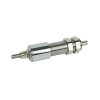Force Sensor
Ring Type Compression Force Sensor, 0.5kN-200kN
Thin Film Force Sensor, 2.5kg-50kg
Tension Force Sensor for Fiber Optic, 10N-500N
Compression Force Sensor, Flat Plate, 0-5 Ton
Grip Force Sensor for Human Grip Strength, 0-10/20/100kg
Piezoelectric Force Sensor, 0-30kN
Miniature Force Sensor, 20-10000kg
Impact Force Sensor, 0-30kN
Pedal Force Sensor, 10-150kg
Micro Force Sensor, 2-100kg
2 Axis Force Sensor, 5kg/10kg/20kg/50kg/100kg
3 Axis Force Sensor, 0-500N/1000N
6 Axis Force Sensor, 100kg/160kg/250kg/500kg
Factory direct sale high quality force sensors. The force sensor is a device used to measure the magnitude and direction of force, typically converting an applied force into a detectable electrical signal. It comes in various configurations, including S-type, cylindrical, miniature, flat, and ring-type. SUCH offers force sensors for detecting compression, tension, and pull. Made of high quality materials and compact in design, they meet diverse application requirements and are ideal for industries such as industrial automation, robotics, and the automotive industry.
How do force sensors work?
Strain-gage force sensors
Strain-gage force sensors operate based on the strain effect of metallic conductors. When an external force acts on the elastic element of the force sensor, the elastic element undergoes a slight deformation. This deformation is sensed by the strain gauge attached to the surface of the elastic element, which then undergoes a corresponding deformation, resulting in a change in its resistance. To convert this slight resistance change into a measurable electrical signal, strain-gage force sensors typically employ a Wheatstone bridge circuit. When the value of one resistor changes, the bridge's equilibrium is disrupted, generating a voltage output. This voltage output is proportional to the magnitude of the external force, so the magnitude of the external force can be determined by measuring the voltage output. Strain gauge force sensors offer high precision and excellent stability, making them suitable for both static and dynamic force measurement.

Piezoelectric force sensors
Piezoelectric force sensors operate based on the piezoelectric effect. When an external force acts on a piezoelectric element, an electric charge is generated. The amount of this charge is proportional to the magnitude of the external force, allowing the magnitude of the external force to be determined by measuring this charge. Because the output impedance of a piezoelectric element is high, a charge amplifier is required to convert the high-impedance charge signal into a low-impedance voltage signal. A signal processing circuit amplifies and filters the converted electrical signal, ultimately outputting an electrical signal proportional to the external force. Piezoelectric force sensors offer advantages such as high sensitivity, fast response, and a wide dynamic range, making them particularly suitable for dynamic force measurement.
What are the types of force sensors?
Compression force sensors
 Compression force sensors measure the force generated when an object is compressed or squeezed. Compression force sensors tend to bear force against their supporting surface and are typically cylindrical or pancake-shaped, making them highly rigid and stable. They typically measure unidirectionally and have a wide range. They offer excellent resistance to off-center loads and lateral forces, ensuring accurate core data even in complex load environments.
Compression force sensors measure the force generated when an object is compressed or squeezed. Compression force sensors tend to bear force against their supporting surface and are typically cylindrical or pancake-shaped, making them highly rigid and stable. They typically measure unidirectionally and have a wide range. They offer excellent resistance to off-center loads and lateral forces, ensuring accurate core data even in complex load environments.
Tension force sensors
 Tension force sensors measure the force generated when an object is stretched or pulled. They possess excellent dynamic response capabilities, enabling them to capture instantaneous changes in tension. Tension sensors are compact and require high mounting coaxiality and mechanical clearance to eliminate interference from non-axial forces and ensure the purity of the measured value.
Tension force sensors measure the force generated when an object is stretched or pulled. They possess excellent dynamic response capabilities, enabling them to capture instantaneous changes in tension. Tension sensors are compact and require high mounting coaxiality and mechanical clearance to eliminate interference from non-axial forces and ensure the purity of the measured value.
What are the uses of force sensors?
- Automation control: Monitoring the pressing force of machinery or machine handling enables precise control and safety throughout the entire production process.
- Robotics: Monitoring robot gripping force assists robots in completing precise assembly tasks and ensures safe human-machine interaction.
- Automotive testing: Controlling battery pack assembly force during electric vehicle testing prevents damage. Car crash testing measures impact forces during collisions and falls to ensure vehicle safety.
- Tension control: In papermaking, textiles, film, and wire and cable production, it is used to test material mechanical properties such as tension, compression, and bending. It also controls tension during the winding and unwinding process to ensure uniform product thickness, wrinkle-free, and unbreakable.






















































